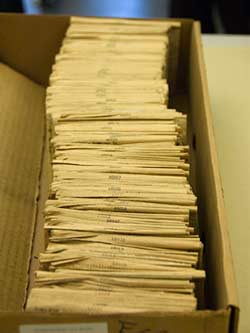 Headstones toppled by the San Francisco quake of 1906 (left) and a Japanese woman awaiting transport to a WWII-era internment camp (right): Among the eras of California history represented in the Bancroft's Pictorial Collection. (photo at right Dorothea Lange)
Headstones toppled by the San Francisco quake of 1906 (left) and a Japanese woman awaiting transport to a WWII-era internment camp (right): Among the eras of California history represented in the Bancroft's Pictorial Collection. (photo at right Dorothea Lange)Picture-perfect preservation
The Bancroft's Pictorial Collection is a repository for the visual resources on which so much historical research depends
| 22 January 2009
 Negatives from the S.F. Examiner photo archives await processing by Bancroft staff. (Steve McConnell photo)
Negatives from the S.F. Examiner photo archives await processing by Bancroft staff. (Steve McConnell photo)BERKELEY — The Bancroft Library's Pictorial Collection is home to 8 million items that document the history of America west of the Mississippi River — primarily California and Mexico — from the late 18th century to the present. It's a large holding for a university library, one that grew by more than 4 million images in 2006 when the Bancroft received the San Francisco Examiner's photograph archives, the largest gift in the library's history.
The Examiner bequest, which spans the decades between 1910 and 1990, augments the collection's documentation of the 20th century, which includes the San Francisco Call-Bulletin's photo morgue (1915-65) as well as the work of individual photographers: Chauncey Hare, Michelle Vignes, Jon Brenneis, Morrie Camhi, and Ted Streshinsky. The Examiner archives complement the cornerstone of the collection, the Robert B. Honeyman Jr. Collection of Western Americana and Art, which includes many major artists of 19th-century and early 20th-century California.
Among the collection's other highlights are photographs by Ansel Adams of the High Sierra; Native American photographs by C. Hart Merriam; 19th-century stereographs by Eadweard Muybridge; Carleton Watkins' images of the Mendocino coast and Yosemite Valley; and construction photos of the San Francisco-Oakland Bay Bridge from the 1930s.
During the Bancroft Library's early days, 75 to 100 years ago, visual works were seen simply as illustrations to accompany textual research, says the Pictorial Collection's curator, Jack von Euw. Today the collection's patrons view images as primary sources on equal footing with text. "The visual expression of history is in some ways more important than some of the textual documents that have been left behind," says von Euw, who notes that, unlike pictures that reflect the day's events, dress, and social milieu, written words are always more of a writer's interpretation.
 This photo from the S.F. Examiner archives shows capital-punishment opponent Marlon Brando outside San Quentin not long before the execution of Caryl Chessman in 1960.
This photo from the S.F. Examiner archives shows capital-punishment opponent Marlon Brando outside San Quentin not long before the execution of Caryl Chessman in 1960. The users of the vast collection include university scholars, from Berkeley and across the globe, as well as the state's K-12 teachers, who use the online California Heritage Project as part of their curriculum. Members of the general public also consult the Bancroft's holdings, be they genealogists, documentary filmmakers, or simply amateur historians.
The Pictorial Collection's works will benefit hugely from the Bancroft Library's new climate-control systems, because the preservation of photographic media that have shorter life expectancies than the average human is largely a race against the clock. Says archivist James Eason: "I think of where many of the archives were before they came to us and what their life expectancy was in someone's garage or attic, where temperatures reach 100 degrees in the summer, or in the basement, where the water line breaks and they're flooded." Getting the images into a stable, cold environment is a truly significant step, he says.
While the collection's new temperature-controlled stacks, vault, and zero-degree freezer room for storing sensitive film were sorely needed, the improved digs don't solve its funding challenges. The next hurdle — and it's a sizable one — is to create a lasting visual record by reformatting film to a digital format. "There isn't any dedicated revenue — either state funds or otherwise — for us to accomplish all that we really need to do in that area," says von Euw.

